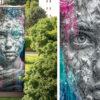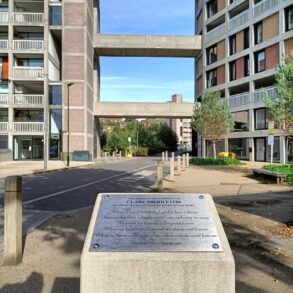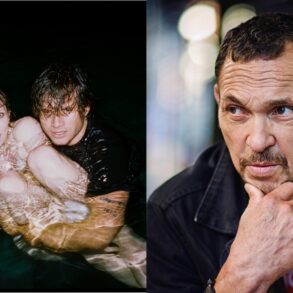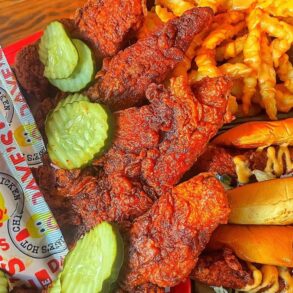Above: 1980, 2020
If you think highbrow vs. lowbrow tiffs are relegated only to film, literature, and music, you need a refresher on the intransigent hierarchies and petty snobberies of the art world. “Sometimes there’s a little bit of a suspicion of work that is ‘too popular,’ ” says Marina Isgro, associate curator of media and performance art at the Hirshhorn Museum and Sculpture Garden in Washington, D.C.
Which may be one explanation for American museums’ sluggish acceptance of graffiti-based art, a.k.a. street art. Though Basquiat famously got his start as one half of the tagging duo Samo and respected artists from Barry McGee to Banksy have emerged from this form of urban rebellion, curators have been likelier to embrace artists’ (seemingly) more mature studio art. But this month, the Hirshhorn will seek to reverse such hesitancy around the genre when it mounts the first U.S. museum survey of Osgemeos, the Brazilian identical-twin brothers Gustavo and Otavio Pandolfo.

Osgemeos
Felipe Berndt
Osgemeos (Portuguese for “the twins”) initially made a name for themselves writing graffiti in the ’80s and ’90s in their hometown of São Paulo, though they have long since expanded into commissioned outdoor murals as well as pieces created in their studio. But whether illicit or invited, outside or in, their dreamy, colorful works share a primary medium: spray paint. “Their skill with spray paint is incredible,” says Isgro, who curated the show. “They are able to create, for example, very subtle shadows using a spray can, which is not easy to do.”
Their mastery of nozzles has helped them invent Tritrez, a magical realm inhabited by distinctive flat figures with broad, often yellow faces, twig-thin limbs, and clothes in bodaciously clashing patterns; the pair claim to have conjured up the place together while still in utero. “It’s very hard for us to explain because we’ve been doing this since before we were born,” they tell Robb Report, speaking as one via email. We’ve been always working on the imaginary between us, between each other, to the point where when one imagines, the other understands what he’s imagining, and vice versa… We are free to imagine life as we think it should be, and for us, it is always positive, joyful, fun, colorful, transforming for the good—always for the good—and opening new doors.”

A Dream in My Hands, 2015
Eduardo O.
Beyond generating ideas in tandem, they add, “we always believed that we didn’t need two pieces of paper but only one, and on that piece of paper we were one.” They continue to draw and paint a single work simultaneously in their practice today.
The brothers’ catholic influences range from local graffiti writers to Brazilian modernist painter Alfredo Volpi to American underground-comics illustrator Vaughn Bodē. In the late ’80s and early ’90s, they got their hands on zines that exposed them to American culture. “They didn’t have access to brands like Adidas, so their grandmother would sew them outfits in imitation of U.S. streetwear,” Isgro explains. “There’s a terry-cloth hat that was made out of a towel and necklaces made out of hood ornaments from cars.” The Pandolfos even painted Nike swooshes onto their plain sneakers.
The Hirshhorn’s presentation, titled Osgemeos: Endless Stories, will be expansive, with roughly 1,000 objects filling the museum’s entire third floor, about 16,000 square feet of exhibition space. In addition to paintings, sculptures, and installations, the trove will include archival materials, such as the twins’ early joint drawings, more than 30 drawings sequencing the evolution of their Tritrez characters, and documentation of their murals and graffiti.
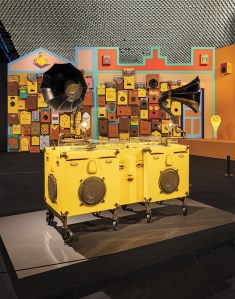
Gramophone, 2016
Filipe Berndt
Among the show’s expected highlights are Untitled (Zoetrope), a pre-cinematic carousel device with a strobe light that makes the handmade sculptures appear to move, and 1980, a shaped painting of three young graffiti artists doing their thing aboard a New York City subway car. “There’s just so much detail on the individual tags of the car and also in the costumes of the characters,” Isgro says, noting that Osgemeos often use sequins, pom-poms, and other craft materials in their studio art. In addition, the brothers, who continue to take DJ gigs, are incorporating music into the exhibition: Untitled (92 Speakers), a wall collage of speaker boxes painted to look like faces, will play the pair’s own beats, and opera music will accompany Moon Room, a vignette of a crescent moon lying in a bed, which visitors will view through a window.
Adding to the joyful vibe: The Hirshhorn is keeping the sprawling exhibition up for more than a year, until July 2025. After all, Osgemeos arrive with a built-in fan base of 1.2 million Instagram followers, definitely qualifying as popular. “They have a huge social-media following,” Isgro notes, “and it’s not the fine-art or high-art crowd, necessarily.” The brothers add, “We hope that this exhibition will open doors to the imagination of everyone who visits it and that it will be a portal to the playful dimension that exists within each of us.”
This post was originally published on this site be sure to check out more of their content.


